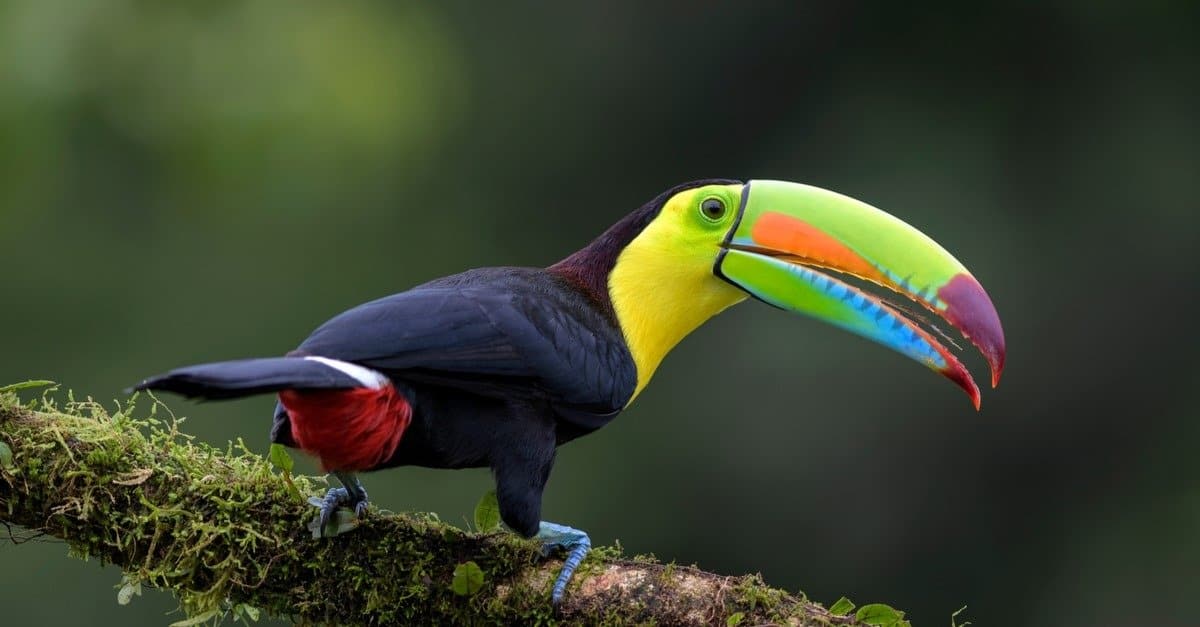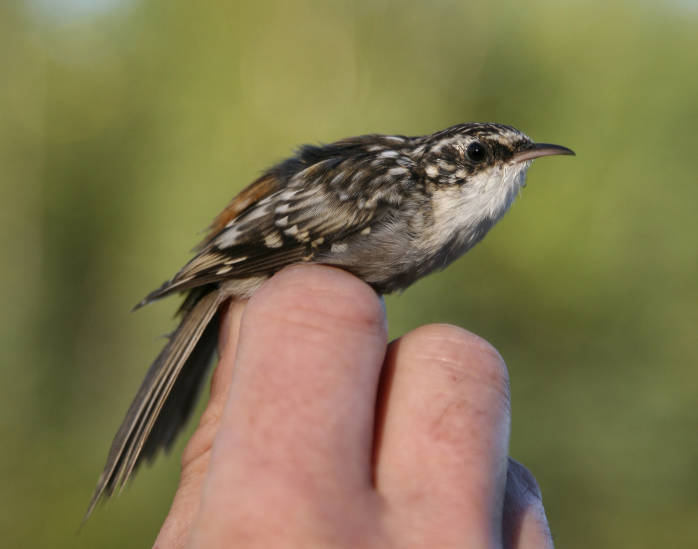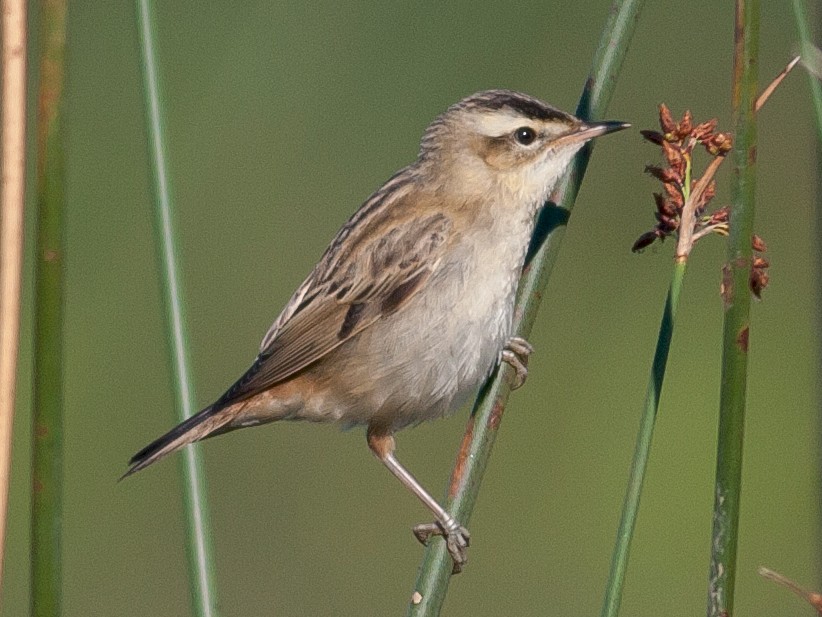With so many bird species on earth, it is no surprise that there are a huge variety of physical traits often reflective of their environments. Beaks are one of the traits documented in Charles Darwin’s trip to the Galapagos, where he noted how the beaks differ depending on the types of food the birds ate.
In this article, we’ll be looking at 16 birds that are specifically small but have long beaks.
1. Black Skimmer

Scientific Name: Rynchops niger
Range: United States and Central American coastlines, South America
The black skimmer is a seabird with a long and thick beak where the upper mandible rests on the much longer lower mandible. The beak is half orange towards the head and half black towards the tip.
The black skimmer is found in coastal habitats near beaches, estuaries, and sandbars.
The black skimmer feeds by flying close to the water’s surface, during which it dips its lower mandible into the water “skimming” for fish. Besides small fish, the black skimmer also eats insects, crustaceans, and mollusks.
2. Keel-billed Toucan

Scientific Name: Ramphastos sulfuratus
Range: Central America (especially Venezuela and Nicaragua)
The keel-billed toucan is a toucan with a large, multicolored beak. It has a lime green head, with black plumage everywhere else. They can be difficult to spot in the leafy canopy, and they’re sometimes known as “flying bananas” during the flight due to their shape.
The keel-billed toucan’s typical habitats include tropical lowland and sub-tropical rainforests that extend from southern Mexico to Venezuela and Colombia. They do not migrate.
Keel-billed toucans are frugivorous birds that consume mainly fruit and berries but have also been seen eating insects, lizards, tree frogs, juveniles, and eggs.
3. Bewick’s Wren
Scientific Name: Thryomanes bewickii
Range: United States, Mexico
The Bewick’s wren is a slender wren with a long tail, dark brown plumage above, gray plumage below, white eyebrows, and a long, slender beak that is slightly curved.
Typical habitats for the Bewick’s wren include dry scrubby areas, open country containing thickets, and open woodlands near rivers and streams. They may also be found in more urban areas, such as gardens, parks, backyards, and suburbs.
The bewick’s wren consumes mainly insects, such as beetles, ants, wasps, true bugs, and caterpillars. They also eat many spiders, along with the occasional berry or seed.
4. Marsh Wren

Scientific Name: Cistothorus palustris
Range: Canada, United States (excluding Alaska), Mexico
The marsh wren is a wren with bright rusty plumage, a darker brown cap, white eyebrows and throat, contrasting black-and-white stripes on the back, and a long slender beak.
The reddish-brown and black plumage, plus its small size, makes it difficult to spot as it moves stealthily through the grass. Compared with the similar sedge wren, the marsh wren is generally darker and more contrasting.
Habitats for the marsh wren are usually limited to cattail marshes and rushes, where they breed, and wet fields, where migrants typically travel to.
The marsh wren feeds mostly on insects, such as beetles, flies, moths, caterpillars, and grasshoppers, among others. They also feed on spiders and invertebrates, the former of which they usually pick from the stems and leaves of marsh vegetation.
5. Sword-Billed Hummingbird
Scientific Name: Ensifera ensifera
Range: Venezuela, Colombia, Ecuador, Peru, Bolivia
The sword-billed hummingbird is a small hummingbird with an iridescent green body, a bronze-colored head, and an extremely long beak. This bird, in fact, has the largest beak-to-body size ratio of any bird in the world.
The sword-billed hummingbird can be found in temperate habitats, such as in mountainous forests and forest edges. They’re typically seen in the tropical cloud forests in the Andean region of South America, at altitudes between 2,400 and 3,100 meters.
As a hummingbird with a very long beak, the sword-billed hummingbird feeds mainly on flower nectar, especially those containing long corollas. These flowers may be from trees, herbs, shrubs, and epiphytes. They prefer flowers that contain a high concentration of sugar and nectar.
6. Rufous-Tailed Jacamar
Scientific Name: Galbula ruficauda
Range: Guatemala, Nicaragua, Colombia, Venezuela, Brazil, Paraguay, Bolivia, Guyana, Suriname
The rufous-tailed jacamar is a slim bird with green and rufous plumage, with a white throat on males and a buffy throat on females. They possess a very long and slender black bill resembling that of the giant hummingbird.
The rufous-tailed jacamar’s typical habitats include the edges of evergreen and humid lowland forests, along with its adjacent clearings.
The rufous-tailed jacamar feeds exclusively on insects, with examples including flies, beetles, bees, dragonflies, butterflies, and wasps. It remains perched with its bill tilted upwards, then flies out to catch insects in midair.
7. Brown Creeper

Scientific Name: Certhia americana
Range: North and Central America
The brown creeper is a small songbird consisting of white underparts, streaks of brown and gray above, a long tail, and a long and narrow curved beak. The brown and gray streaks allow the bird to blend easily into tree bark. Brown and gray contrasting wing stripes can be seen in flight.
The brown creeper breeds in mature evergreen or mixed evergreen and deciduous forests (especially those with conifers), where they’re found at elevations as high as 11,000 feet. During the winter, they move to a wider range of forests and become easier to locate in deciduous woodlands.
Brown creepers eat mainly insects throughout the year, but as winter approaches, they will add more suet, peanut butter, as well as sunflower, pine, and grass seeds to their diet. They’ll also consume the occasional corn.
8. Sedge Warbler
Scientific Name: Acrocephalus schoenobaenus
Range: Europe, Southeastern Africa
The sedge warbler is a small warbler with contrasting gray eyebrows and black crown stripes, dark brown upperparts with streaks, pale underparts, and a relatively long beak. Juveniles have light brown streaks on their breast.
Typical habitats for the sedge warbler include marshes and scrubby lands containing reeds, brambles, and bushes, though they’re not usually found in pure reed beds. They may be found in drier habitats during migration.
The sedge warbler’s diet usually contains a range of bugs and insects, including dragonflies, spiders, and beetles. As winter approaches, it’ll consume more berries and aphids to prepare for scarcer food in the cold weather.
9. Malachite Kingfisher
Scientific Name: Corythornis cristatus
Range: Central and Southern Africa
The malachite kingfisher is small with orange underparts, though a small minority may have a white belly. Their backs are dark blue, and they have a long and sturdy orange beaks.
Overall, they look similar to the pygmy-kingfisher; however, they’re larger, have less orange plumage on their face, and prefer habitats with water.
The malachite kingfisher can be found in just about all habitats containing water, such as streams, rivers, lakes, rice paddies, lagoons, swamps, and marshes. They may also be found in a variety of man-made habitats, including canals, irrigated fields, and reservoirs.
Per its namesake, the malachite kingfisher prefers fish as its main food source. Other prey includes prawns, crabs, frogs, and insect larvae.
10. Slender-Billed Scimitar Babbler
Scientific Name: Pomatorhinus superciliaris
Range: Himalayas, North-western Vietnam
The slender-billed scimitar babbler is a passerine bird that is mainly orange-brown, with a gray head and jagged white eyebrows. Its beak resembles a sword, with its extremely long length and curve.
Typical habitats for this bird include high-altitude evergreen, subtropical, and tropical moist montane forests. They prefer areas with thick undergrowth and those covered with bamboo thickets.
With its long beak, it may not come as a surprise that this bird prefers nectar from flowering trees. They’re also known to consume bamboo, hence why they can often be found where bamboo is abundant.
11. Canyon Wren

Scientific Name: Catherpes mexicanus
Range: Western United States, Mexico
The canyon wren is a small songbird with orange-brown plumage scattered with small black-and-white spots throughout, a bright white throat, and a long and slightly curved beak. Its appearance is similar to the rock wren, albeit with a more contrasting white throat.
The canyon wren can be found in rugged habitats, such as along cliff faces, talus slopes, rocky bluffs, gorges, and canyon walls containing large boulders. Their nests may be found in the crevices of cliffs, banks, and small caves.
The canyon wren feeds mainly on insects and spiders, which they pull out of rock crevices using their long and thin beaks. Among others, common insects include leafhoppers, termites, ants, wasps, beetles, and moths.
12. Red Crossbill
Scientific Name: Loxia curvirostra
Range: North America, Central America, Europe, Central Asia
The red crossbill is a finch with a rather large head, a long, crossed bill, and, for males, red or orange plumage with gray or brown highlights. Females are of a light olive-yellow color. Compared with adults, juveniles are streakier and have brown wings with no wing bars.
The red crossbill inhabits a range of habitats, from taiga forests in Alaska to montane coniferous forests in Georgia. Their largest populations are found amongst mature coniferous forests in the mountains and in boreal forests.
The red crossbill consumes mainly the seeds of spruce, pine, Douglas-fir, hemlock, and larch trees. They may also consume the buds of trees, berries, weed seeds, and aphids on occasion. Their crossed beak is specifically used to pry out the seeds from conifer cones.
13. Carolina Wren

Scientific Name: Thryothorus ludovicianus
Range: Midwestern and Eastern United States, Occasionally in southern Canada, Mexico, and Guatemala
The Carolina wren is a small wren with white eyebrows, bright brown plumage above, brown-orange plumage below, a very long tail (about the same length as its body), and a long and slightly curved beak.
The Carolina wren prefers forested areas with dense vegetation, where they are often hidden in the tangled understory or brush piles. They may also visit urban areas, such as backyards, where they are sometimes hidden in a drainpipe or grill. They may occasionally visit feeders.
A typical diet for the Carolina wren includes about 95% insects and 5% seeds and plant matter. Insects may include caterpillars, beetles, true bugs, grasshoppers, crickets, and many other kinds. They will sometimes feed on suet or mealworms at feeding stations.
14. Brown-Headed Nuthatch

Scientific Name: Sitta pusilla
Range: Southeastern United States
The brown-headed nuthatch is a small nuthatch consisting of a brown cap, creamy-colored underparts, a gray back, and a long, sturdy beak. Appears similar to the pygmy nuthatch despite there being no overlap in range.
The brown-headed nuthatch is mainly seen in the southeastern pine forests, where there is an abundance of loblolly, shortleaf, longleaf, and slash pine trees. Overall, they’re more often seen in open and mature pine forests than in mixed pine-hardwood stands.
Insects, spiders, and seeds make up the majority of the brown-headed nuthatch’s diet. It consumes more insects and spiders in the summer and more seeds (specifically pine seeds) in the winter. They have been observed carrying loose pieces of bark in their beaks to use them to pry open other pieces of bark to search for insects and spiders.
15. Hairy Woodpecker

Scientific Name: Dryobate villosus
Range: Midwestern and Western United States, Canada, Central America
The hairy woodpecker is a medium-sized woodpecker consisting of black-and-white plumage, white outer tail feathers, and a long thick beak that’s about the length of its head. Birds in western North America and Central America are browner in color compared to those in other regions.
The hairy woodpecker prefers mature forests across North America but can also be found near forest edges, in open woodlands containing oak and pine, and in recently burned forests. They may also be found in urban settings, such as suburbs, parks, and cemeteries.
The hairy woodpecker consumes mainly insects, such as the larvae of wood-boring beetles, adult beetles, ants, caterpillars, and others. They may also consume some berries, seeds, and nuts occasionally. They are particularly fond of suet at backyard feeders.
16. Collared Aracari

Scientific Name: Pteroglossus torquatus
Range: Central America, Colombia, Venezuela
The collared aracari is a small toucan consisting of a yellow body with red and black markings, a long tail, and a large and broad beak with a serrated pattern. Their long tail and beak are especially prominent during flight.
The collared aracari is found in tropical lowland forests and forest edges. They don’t tend to live above 1,000 meters. They may also breed in more open woodlands.
The collared aracari consumes mainly fruit but will also eat large insects and small vertebrates, including the eggs of other birds and juvenile birds.
Conclusion
The list we’ve gone over in this article is certainly not exhaustive, but hopefully, it’s enough to show you just how large the diversity of birds really is.
Something as specific as a small body size with large beaks can generate a huge list of bird species from across the world. Though you may have a little trouble finding these small birds, as long as you’re well prepared and know where to look, it shouldn’t be too difficult a task.
Related articles:
15 Types of Toucans You Didn’t Know Existed








